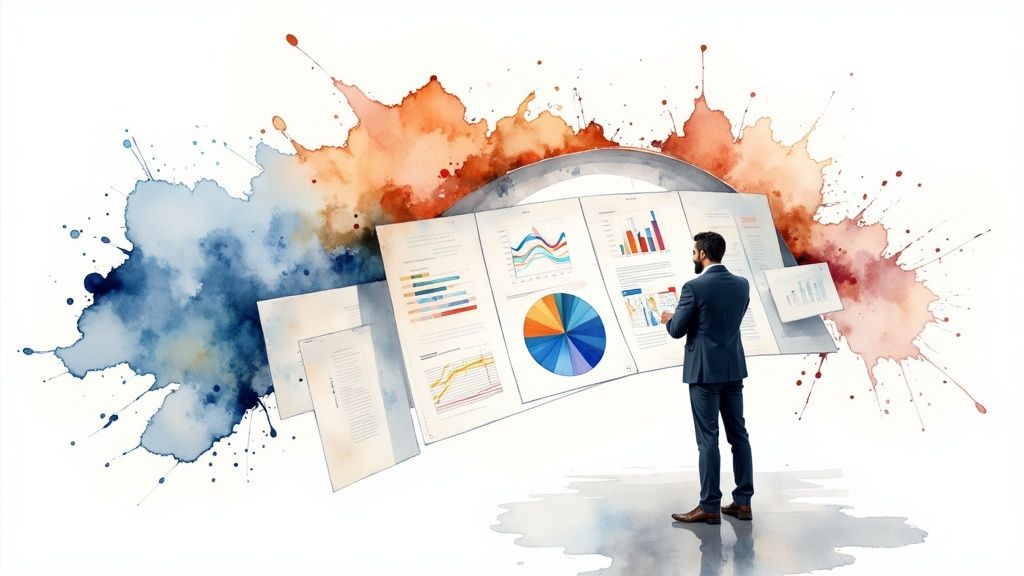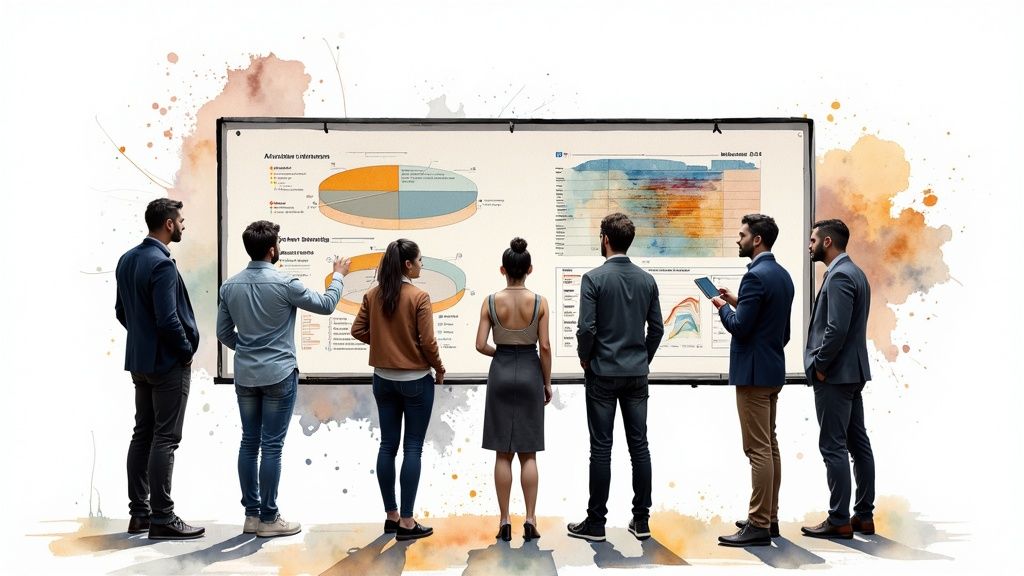
Data Visualization Best Practices: The Ultimate Guide To Creating Clear and Compelling Visuals
Choosing The Right Chart Type For Your Story
Just like selecting the right tool for a job, picking the best chart type is essential for communicating your data effectively. Each type of chart has specific strengths that make it ideal for certain kinds of information. Making a thoughtful choice ensures your message comes through clearly to your audience.
Understanding Your Data's Purpose
Before exploring chart options, take time to clarify what story you want your data to tell. Are you highlighting trends across time? Comparing different categories? Showing relationships between variables? Your answer guides which visualization will work best. For example, line charts excel at displaying trends, while bar charts are perfect for comparing distinct groups.
Matching Charts to Data Types
Different charts are naturally suited to specific kinds of data. For example, line charts track changes over time by connecting data points, making patterns easy to spot. Scatter plots reveal how two variables relate to each other, while pie charts show parts of a whole. Understanding these natural pairings helps you pick the most effective option. Learn more about choosing charts at GoodData.
Considering Your Audience
Think carefully about who will be viewing your charts. Technical experts may grasp complex visualizations easily, but general audiences often need simpler formats. For example, when presenting to executives, a clear bar chart showing key metrics often works better than an intricate network diagram. Match the chart's complexity to your viewers' expertise.
Avoiding Chart Overload
While multiple chart types can work together effectively, be careful not to overwhelm viewers with too much visual information at once. Each chart should serve a clear purpose in telling your story. Consider using interactive features that let people explore details at their own pace. This helps strike a balance between showing comprehensive data and keeping displays clean and focused.
Mastering The Art Of Proportional Data Display

Understanding how different parts contribute to a whole is essential for making data-driven decisions. While pie charts are common, there are many other effective ways to display proportional relationships in data. Let's explore how to select and optimize the right visualization method for your specific needs.
Choosing the Right Tool for the Job
Different visualization types serve different purposes when showing proportional data. For example, treemaps excel at displaying hierarchical data where categories break down into subcategories. Sunburst charts offer a circular layout that makes parent-child relationships clear. The key is matching your visualization choice to both your data structure and the story you want to tell.
The Power of Pie Charts (and When to Avoid Them)
Pie charts work well for simple comparisons with just a few categories. However, they quickly become hard to read with more than 6-7 segments. Learn more about effective pie chart usage here. When dealing with many categories, consider using a bar chart or treemap instead. These alternatives make it easier to compare multiple segments accurately.
Optimizing Proportional Visualizations
Clear labels placed directly on or next to data segments help readers quickly grasp the information. A thoughtful color palette improves readability and highlights differences between segments. Arranging segments in a meaningful order, such as largest to smallest, makes patterns more apparent. Small tweaks like these make a big difference in how easily viewers can interpret the data.
Combining Visualizations for a Richer Story
Using multiple chart types together often tells a more complete story. For instance, pair a pie chart showing market share percentages with a bar chart detailing actual sales numbers. This gives both the high-level view and the specific details readers need. Consider how different visualization types can work together to help your audience fully understand the data's meaning and implications.
Transforming Data Into Compelling Narratives
Great data visualization goes beyond just displaying numbers and charts – it's about crafting stories that connect with people. When done well, data storytelling combines visual elements with narrative techniques to highlight key insights in ways that stick with viewers. By thoughtfully structuring data and adding meaningful context, we can help audiences understand complex information and see why it matters. Learn more about effective approaches to data visualization in this comprehensive guide.
Structuring Your Data Story
Like any good story, data narratives need a clear beginning, middle and end. Start by identifying the main message you want viewers to take away. Then map out how different data points build on each other to support that key insight. Each element should flow naturally into the next, guiding your audience through a logical progression of ideas.
Creating Context and Meaning
Raw numbers only tell part of the story. To make data truly meaningful, provide essential background that helps viewers grasp why the information matters. This might include explaining data sources, defining key metrics, or showing how current trends compare to historical patterns. For instance, when sharing sales figures, include details about market conditions to give proper perspective.
Engaging Your Audience
Keeping viewers interested requires clear communication and thoughtful design. Use descriptive titles that highlight key findings. Choose visuals that clarify rather than complicate. Add interactive elements that let people explore data at their own pace. Consider your audience's knowledge level and interests when deciding how to present information.
Combining Quantitative and Qualitative Data
While numbers provide a solid foundation, adding qualitative context creates richer understanding. Pairing statistics with real examples, customer quotes, or expert insights helps bring data to life. This balanced approach helps viewers connect analytical findings to real-world impact. Think of it like sports commentary – statistics show what happened, but analysis and examples explain why it mattered. Together, these elements create clearer and more persuasive data stories.
Making Data Visualization Work for Business

Data visualization has become essential for any business that wants to make the most of its information and improve decision making. Companies need to go beyond just creating charts and graphs – they must understand why visualizations matter and who will use them. By taking a strategic approach to data visualization, organizations can drive real business results.
Making Data Accessible to Everyone
When complex data is presented visually, it becomes much easier for all employees to understand key insights, regardless of their technical background. For instance, a sales team can quickly spot trends in a line chart that might be buried in spreadsheet rows. This universal access to data helps create a data-driven culture where decisions come from evidence rather than guesswork.
Improving Communication Between Teams
Visual data acts like a shared language that helps different departments collaborate better. When teams can see the same charts and graphs, it's easier to discuss findings and spot connections between different parts of the business. For example, marketing and product teams might notice patterns in customer behavior that weren't obvious when looking at separate reports. This is especially helpful in larger companies where information often stays trapped in departmental silos.
Tracking Results and Growing Successfully
To know if data visualization efforts are paying off, companies should monitor specific metrics tied to their goals. If you want to boost customer satisfaction, look at how feedback scores change after adding visual dashboards. The growing importance of data visualization is clear from market projections – experts expect the industry to reach $20 billion by 2031. Learn more details at Exploding Topics.
Creating a Data-First Mindset
When employees can easily access and understand data through visuals, they're more likely to use it in their daily work. This shift toward data-driven decisions leads to better outcomes and new ideas. But having great visualizations isn't enough – companies need to train their people to interpret data correctly and feel confident using it. Success requires ongoing commitment to both the technical tools and the human skills needed to use them effectively.
Mastering Color Theory And Visual Hierarchy

Good data visualization relies on thoughtful color choices and clear visual organization. These elements help guide viewers through complex information while making key insights stand out. Let's explore practical ways to use color and visual structure to create clear, engaging visualizations.
Understanding Color's Impact
Colors do more than decorate – they shape how people understand information. Warm colors like red and orange naturally draw attention to important points, while cooler shades like blue and green work well for supporting details or background elements. By using color deliberately, you can help viewers quickly grasp the main message of your visualization.
Key Color Theory Principles for Data Visualization
- Color Harmony: Pick colors that naturally complement each other, like neighboring shades on the color wheel, to create a pleasant and readable chart
- Color Contrast: Make sure there's enough difference between your data points and background for easy reading – aim to meet WCAG accessibility standards
- Color Meaning: Remember that different colors spark different emotional responses and associations that can support or detract from your message
Building a Strong Visual Hierarchy
A clear visual structure helps people follow your data story in a logical way. Here are key techniques to guide viewers' attention:
- White Space: Use empty areas purposefully to prevent visual clutter and let important elements breathe
- Font Variation: Different text sizes and weights create natural emphasis – larger, bolder text draws the eye first
- Visual Guides: Simple lines, shapes and icons can help group related information and show relationships between data points
Designing for Different Contexts
Your visualization needs to work well wherever people view it. Keep these factors in mind:
- Screen Size: Charts that look great on desktop may become unreadable on mobile. Build responsive designs that adapt
- Print vs Digital: When designing for print, choose colors and fonts that maintain clarity on paper – avoid very light shades that might fade
By applying these visualization principles thoughtfully, you can create charts and graphs that both look good and communicate clearly. This helps ensure your audience can understand and act on the insights in your data.
Building Interactive And Responsive Visualizations
Effective data visualization goes beyond creating static charts – you need to build charts that immediately engage your audience while adapting smoothly across devices. Let's explore how to create visualizations that invite exploration and maintain clarity.
Balancing Functionality and User Experience
When adding interactive features, focus on elements that enhance understanding rather than creating confusion. Keep your visualizations clean and purposeful by including features that help users:
- Explore data details: Enable users to click or hover for additional information about specific data points
- Filter important information: Add controls that let viewers focus on the data most relevant to them
- Switch between views: Make it easy to toggle between different ways of looking at the same dataset
Implementing Effective Interactive Features
Today's visualization tools provide several ways to make data more engaging:
- Smart tooltips: Show helpful context when users hover over data points without making the main view too busy
- Smooth transitions: Use subtle animation to highlight changes and guide attention to key patterns
- Connected charts: Link multiple visualizations so that interactions in one chart update related views. For example, selecting a category in a bar chart could filter the data shown in a line graph.
Ensuring Responsiveness Across Devices
With increasing mobile data access, responsive design is essential. Focus on:
- Touch-friendly controls: Make interactive elements easy to tap and swipe on smaller screens
- Flexible layouts: Design visualizations that adjust gracefully as screen size changes
- Smart loading: Start with core data and use progressive loading to add detail as needed, especially on mobile networks
Optimizing Mobile Experiences for Data Visualization Best Practices
Mobile screens present unique visualization challenges that require careful design choices:
- Focused mini-charts: Break complex visualizations into a series of simpler, focused views
- Key metrics first: Show the most important numbers up front while allowing users to dig deeper
By following these guidelines, you can create data visualizations that effectively engage users and communicate insights across all devices.
Ready to improve your data-driven decision making? See how Derisky.ai can help optimize your innovation process and achieve measurable business results.







